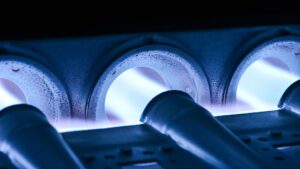Efficiency is an easy thing to forget about until your heating bills come at the end of the month. Then, you’re looking at a big price tag that you have to pay, and this happens throughout the entire winter.
So, when exploring options for a furnace installation in Glenpool, OK, you’ll want to know how efficient the system is and how likely you are to save money on your heating bills month after month. This can be easily understood, and as your licensed professionals in the area, we’re happy to teach you.
Just remember that furnace installations and repairs are never to be done by anyone other than a licensed professional. Your furnace deserves the best care and your comfort should never be compromised.
Furnace Types
Before we can talk about the efficiency of a furnace system, we need to talk about the several types of furnaces you can choose from. Most importantly, the most modern furnace types are electric and gas.
While gas furnaces are the most common system that you’ve probably already heard of, furnaces can also be all-electric which is great for homes that are off-the-grid.
Gas furnaces run efficiently due to the affordability of natural gas and the fact that gas turns into heat at an exceptionally good rate. Electric furnaces run via electrical resistance, heating up a large coil that produces warmth.
The Efficiency of Each Furnace
Furnaces can be efficient or inefficient–the difference depends on the system. Old wood-burning furnaces from the 80s can produce heat for a home, but they’re wildly inefficient, producing more carbon dioxide and smoke than actual usable heat. Electric or gas furnaces, on the other hand, turn most of their fuel or energy into heat.
Electric furnaces are technically 100% energy efficient, but that energy is more expensive because it’s electricity. Even though 100% of the electricity is being turned into heat, that energy costs more per kilowatt and you’ll be paying for it.
Gas furnaces are still pretty efficient, but that efficiency might depend on the AFUE rating of the system.
The AFUE Rating
Gas furnace efficiencies are measured in “AFUE” which stands for “annual fuel utilization efficiency,” and it’s the methodology used to see how cost-effective your system will be. Basically, it represents a percentage of the gas being turned into heat for your home. Anything that’s not included in this number, gets expelled from your home as fumes, carbon dioxide, carbon monoxide, and water vapors.
A gas furnace with a low AFUE is inefficient and it’s likely consuming more gas to keep your home comfortable. Similarly, a unit with a high AFUE (like 90+) can turn even a small amount of gas into plenty of heat for your home. These units cost less to operate on a monthly basis, and they’re worth the higher installation cost due to their improved efficiency.
Don’t forget–couple your furnace with a maintenance plan to ensure it stays efficient throughout its entire lifespan.
For help with your next furnace purchase, contact JC Mechanical, The Wizard of Blizzard!

